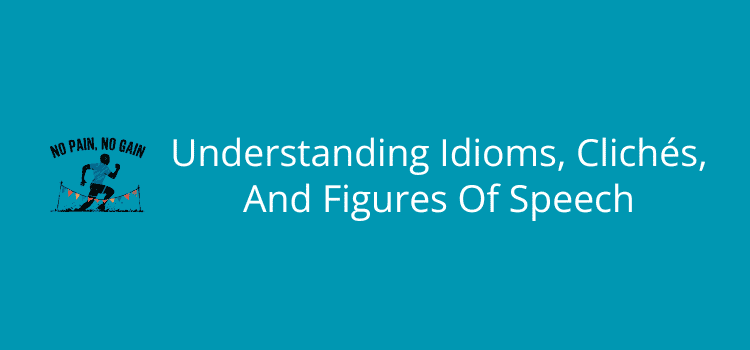
Two common types of fixed expressions we use in writing are idioms and clichés.
Idioms can help with variety by expressing ideas in a figurative way instead of a long-winded literal explanation.
Clichés, although similar, are phrases that we see repeated so often that they risk showing a lack of thought in writing.
While both are figures of speech, telling the difference can help improve your writing by making better choices.
Idioms and clichés: What’s the difference?
Idioms are phrases that have a figurative meaning. That is, the meaning can’t be deduced from the individual words in the saying.
A good example is, “Has the cat got your tongue?” The meaning has nothing to do with a cat and is only slightly connected to a tongue. The meaning is that you are asking someone why they are silent and not speaking.
Idioms typically come from cultural, historical, or everyday contexts, but many of them have been part of the language for a very long time.
However, they can still help convey complex ideas quickly, which is useful for making your writing concise, yet colorful.
The great thing about idioms is that most of your readers will recognize and understand them.
Clichés are a different kettle of fish. Like the ending of my last sentence, they are expressions that suffer from overuse.
Examples might include “head over heels,” or “the early bird catches the worm.”
Of course, expressions like these were probably fresh and inventive a long time ago, but over time, they have become clichéd from overuse.
Choosing the best expression usually depends on the context and your readers.
An idiom might liven up dialogue or a description, but a cliché could weaken the same sentence.
Figures of speech: The bigger picture
Because writers use so many language terms, it can become confusing because they often sound similar. Parts of speech are nouns, pronouns, verbs, and adjectives, etc.
Figures of speech, however, are a very broad grouping of expressions that use figurative language.
They include idioms, clichés, metaphors, similes, hyperbole, oxymorons, and many other literary devices. They can also include sayings or set expressions.
As you can see, idioms and clichés are only two types within this very broad category.
Including figures of speech occasionally in your writing can help you with style, emphasis, or even precision.
In general, idioms can help you with emphasis or creativity, while clichés are most often weak, repeated, and all too familiar phrases.
Here are some better choices you can use.
Metaphors and similes both compare one thing to another to help create figurative imagery.
For example, “He’s as solid as a rock,” or “He’s the rock of my life.”
Hyperbole exaggerates for effect.
Here’s a well-known example: “I have a million things to do today.”
Personification adds human qualities to things or objects. Example: “The armchair sighed as she flopped into it.”
Whenever you use a figure of speech, it should serve a specific purpose. Do you want a sentence to be more memorable, vivid, or persuasive?
Understanding figures of speech can also help you to improve your editing. You can ask yourself whether certain expressions improve meaning or only serve as fluff.
Using idioms in your writing
If you use them thoughtfully, idioms can help you add variety and imagery to your writing.
A well-placed idiom can work well, but too many can make your writing seem unoriginal.
One of the best ways to make idioms more effective is to modernize them.
Instead of using a familiar idiom like “burning the midnight oil,” you could say “running on caffeine and Wi-Fi” to help convey the same idea, but with a modern twist.
Rewriting an idiom can also add some humor. For instance, “like a broken record” could become “like a TikTok on repeat,” which updates the imagery and might make your readers smile.
You can also try to adapt idioms to fit your subject or writing style. If you’re a tech writer, you could replace “don’t put all your eggs in one basket” with “don’t put all your files in one cloud.” The structure of the idiom is the same, but the new version could work better for your audience.
Another strategy is to twist an idiom just enough to surprise the reader. For example, instead of “the tip of the iceberg,” you could try “the loading bar stuck at 5%,” which conveys the same sense of something bigger hidden beneath the surface.
Idioms can work well if you use them sparingly, and only when they really fit the context.
For fiction, articles, or conversational nonfiction, they can make your voice sound natural and interesting.
Don’t be afraid to invent your own spin on old idioms. Language evolves, so try something new.
Should you avoid clichés?
Clichés are always tricky because they feel so natural when you write, but do they add strength to sentences?
In most cases, no, because they are so familiar that readers often read past them. Author bios are often a good example.
Common phrases like “at the end of the day” or “the calm before the storm” don’t really give readers anything new.
You can think of them as shortcuts that can make your writing seem a bit lazy, even if your idea, subject, or story is strong and worth reading.
That doesn’t mean clichés are always a bad idea. Sometimes a tired cliché might work if you’re writing dialogue and want a character to sound ordinary.
You could also use one ironically to make a point. In these cases, it’s deliberate rather than careless.
When you find yourself using a cliché, try to think of a new way to use the structure of the expression.
Instead of using “avoiding it like the plague,” you could try “dodging it like a spam email.”
Rather than “time heals all wounds,” you could try “time dulls the pain.”
Another option is to strip a cliché back to its core meaning. What does “all that glitters is not gold” mean? Probably, appearances can be misleading or deceiving.
Then, try to rephrase it in your own words. Perhaps, “not everything that sparkles is worth keeping.”
You can also update clichés by giving them a new twist. A phrase like “every cloud has a silver lining” might become “every cloud has a Wi-Fi signal”. It’s still recognizable, but maybe surprising enough to grab a reader’s interest.
The bottom line is that clichés aren’t always a bad idea, but relying on them too often can weaken your writing.
A good idea is to mark them as placeholders when writing your first draft. Then, revisit them during your editing stage to be sure they work.
Whether you’re searching for an idiom, dodging a cliché, or playing with a metaphor, the key factor is intention. Use the tools to sharpen your meaning, not to fill space.
Refreshing clichés and giving idioms a modern twist
Most set expressions have been around for ages, so they can often seem bland or overused.
But the good news is that with a little creativity, you can use the structures to produce something new. You can give your figurative language a modern spin, but keep the humor, imagery, and meaning intact.
Surprising your readers with a new take will help make your writing feel fresh.
Here’s a quick list of fifteen classic phrases with contemporary alternatives to show you how you can modernize them.
1. Pigs might fly → When my phone stays charged all day
2. Aspiring author → Novelist under construction
3. The grass is always greener on the other side → The Wi-Fi always seems stronger next door
4. Bite the bullet → Click the update button
5. A picture is worth a thousand words → A screenshot is worth a thousand explanations
6. A watched pot never boils → A watched progress bar never loads
7. Like a fish out of water → Like flip-flops at a wedding
8. Keeping up with the Joneses → Keeping up with the TikTok trends
9. It’s no use crying over spilled milk → It’s no use crying over spilled oat milk latte.
10. Bestselling author → Occasionally best-selling, mostly coffee-drinking author
12. Kicked the bucket → Unplugged for good
13. From rags to riches → From side hustle to CEO
14. You can’t judge a book by its cover → You can’t judge a book by its thumbnail
15. A leopard can’t change its spots → An influencer can’t change their algorithm
You can steal them if you like, but it might be a good idea to come up with your own, and better, alternative expressions.
Summary
Idioms and clichés might seem like minor details, but they can help shape your writing voice and bring a level of freshness to your writing.
Idioms can help with concise, sharp imagery, while clichés risk sounding tired unless you refresh or repurpose them.
But they are only two of the much wider family of figures of speech, which give you the tools to make your writing more vivid, precise, and memorable.
When you choose set expressions, sayings, or idioms with intention, they can add that little bit of extra sparkle to your writing. But don’t overdo it.
Related Reading: How To Use Uncommon Words Without Confusing Readers
Share This Article


